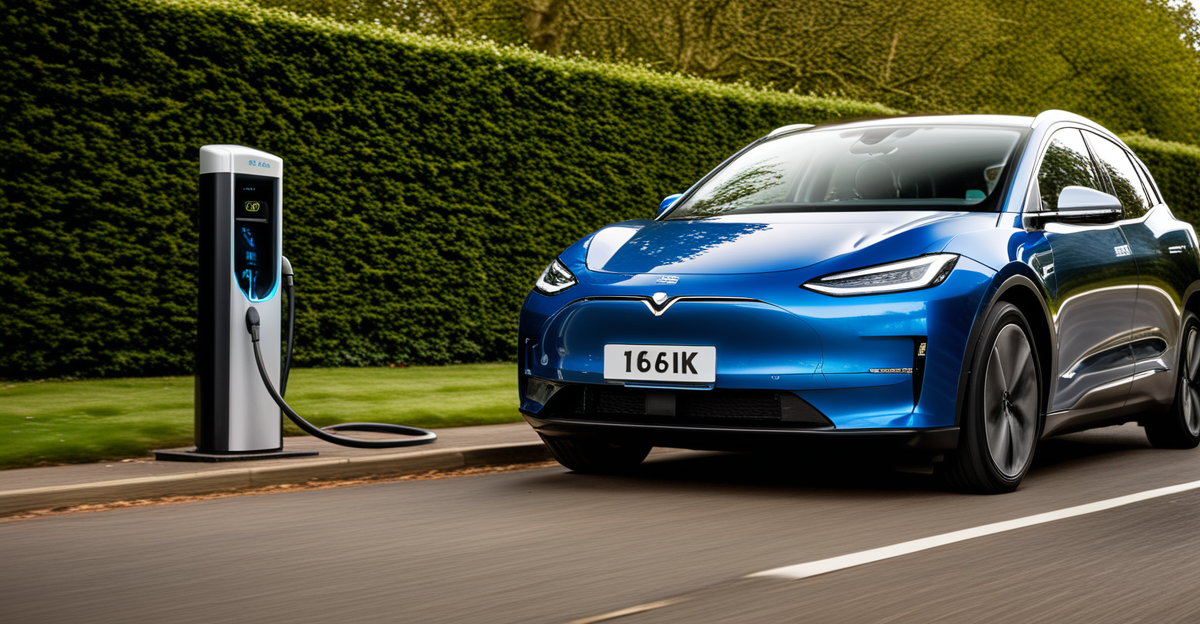Current State of Electric Vehicle Adoption in the UK
The UK electric vehicle adoption rates have shown a marked increase over recent years, with EVs now constituting a growing share of new car registrations. According to recent EV statistics UK, plug-in electric vehicles accounted for around 20% of new car sales in the first half of 2024, reflecting strong consumer interest and shifting market dynamics.
In terms of market share, electric vehicles remain a small but swiftly expanding segment compared to conventional petrol and diesel cars. The UK EV market trends reveal that government incentives, improved vehicle models, and rising environmental awareness are driving factors behind this surge.
Have you seen this : What role do government policies play in the UK’s automotive innovation?
Notable growth milestones include the doubling of EV sales year-on-year in some quarters and the increasing availability of versatile, affordable models. Additionally, hybrid vehicles continue to bridge the gap for consumers transitioning away from traditional engines. These trends highlight the UK’s trajectory towards greater EV integration within its transport ecosystem, setting a foundation for further expansion as infrastructure and policies evolve.
Key Barriers to Widespread EV Adoption
One of the primary barriers to EV adoption UK faces is the high upfront cost of electric vehicles. Despite reductions over recent years, many potential buyers find EV cost UK remains prohibitive compared to conventional cars. This significantly limits affordability, especially for middle-income households.
Also read : How is technology influencing the evolution of UK automotive design?
Another major concern is range anxiety, where drivers worry about the availability and reliability of charging points. The UK electric vehicle infrastructure challenges UK include insufficient rapid charging networks outside urban centres, inconsistent charger reliability, and lack of convenient home charging for apartment dwellers. These complications cause hesitation in fully embracing EVs.
Public perception also plays a crucial role. Many consumers lack awareness of total cost benefits, such as lower running costs, government incentives, and evolving technology. Misinformation and uncertainty about battery life, maintenance, and resale value contribute to slower adoption rates.
Addressing the barriers to EV adoption UK requires coordinated effort to reduce vehicle costs, expand and modernise charging infrastructure, and improve consumer education. Only by tackling these intertwined challenges comprehensively can the UK EV market trends continue their promising growth trajectory.
Government Strategies and Incentives
Recent UK EV policies demonstrate a clear commitment to accelerating electric vehicle adoption. The government continues to offer electric vehicle incentives UK, such as purchase grants that reduce the initial EV cost UK by thousands of pounds. These grants make EVs more accessible, especially to first-time buyers. Additionally, tax benefits like reduced Vehicle Excise Duty and exemptions from congestion charges further incentivise switching to electric.
Significantly, the introduction and expansion of low-emission zones in many UK cities create financial motivations for drivers to choose EVs over petrol or diesel vehicles. These zones discourage high-emission vehicles by imposing fees or restrictions, directly influencing urban travel behaviours.
Public sector investment is pivotal in these strategies. The government funds infrastructure upgrades and innovation projects, supporting both EV adoption and the enhancement of electric vehicle infrastructure challenges UK. For example, financial backing for building more rapid charging stations and home charging solutions complements efforts to alleviate range anxiety.
Together, these government support EVs UK measures address multiple adoption barriers simultaneously—cost, convenience, and regulatory environment—forming an integrated approach that underpins the UK’s growing EV market trends.
Advancing Charging Infrastructure
Expanding EV charging infrastructure UK is essential to overcoming current electric vehicle infrastructure challenges UK that impede adoption. The growth of rapid charging networks UK addresses range anxiety by enabling faster refuelling times, crucial for drivers travelling long distances beyond urban centres. Investment in high-capacity rapid chargers along motorways and in regional hubs is gaining momentum, reducing charging delays and increasing reliability.
Complementing public charging, boosting home charging solutions UK is vital, especially for residents without private driveways. Grants and subsidies encourage installation of domestic chargers, facilitating convenient overnight charging. Workplace charging also plays a role, allowing EV owners to top up during the day, further enhancing practical accessibility.
Collaboration between government, private sector, and local authorities accelerates infrastructure deployment. Innovative business models, like subscription-based access and integrated payment systems, improve user experience. Ensuring chargers are compatible across different EV models is another priority to increase usage and customer confidence.
In sum, advancing EV charging infrastructure UK combines the rollout of widespread rapid networks with support for home and workplace charging. This multi-faceted approach directly targets the infrastructural barriers limiting EV adoption, supporting the UK’s transition towards a cleaner transport future.
Learning from International Best Practices
Studying international EV policy comparison reveals clear patterns in countries with high electric vehicle adoption. For instance, Norway leads by combining substantial subsidies, zero-emission vehicle mandates, and extensive charging infrastructure. This holistic approach boosts both supply and demand, accelerating adoption rates far beyond the UK’s current pace.
Similarly, the Netherlands has succeeded through integrated urban planning and significant investment in public EV charging infrastructure, enhancing convenience and visibility. Their policy framework includes incentives for both consumers and manufacturers, fostering a supportive ecosystem that the UK can emulate.
These global EV adoption lessons highlight key factors: robust financial incentives, regulatory support, and reliable infrastructure. Case studies EV uptake show that simply reducing purchase costs or expanding chargers is insufficient alone; alignment of policies with consumer needs and industry capabilities is essential.
Applying these insights to the UK context involves tailoring best practices to local conditions, such as geography and existing infrastructure. Collaborative efforts across government, industry, and communities can leverage proven strategies, addressing current barriers to EV adoption UK. Learning from successful international models offers a valuable roadmap, accelerating the UK’s transition towards widespread electric vehicle use.
Expert Insights and Stakeholder Perspectives
Experts across the UK automotive industry emphasise that overcoming barriers to EV adoption UK requires collaborative innovation. EV expert opinions UK highlight that manufacturers are rapidly improving EV range and affordability, responding directly to consumer concerns. Industry leaders advocate for continued government incentives and regulatory clarity to sustain momentum.
From an automotive industry perspectives viewpoint, stakeholders note the necessity of integrating battery supply chains and investing in next-generation technologies. These efforts are critical for scaling production and reducing EV cost UK, ultimately making electric vehicles more competitive with petrol and diesel cars.
Feedback from EV owners and advocacy groups reveals mixed experiences. While many appreciate lower running costs and environmental benefits, concerns persist about charging accessibility and vehicle variety. This input guides manufacturers and policymakers to prioritise user-friendly infrastructure and diverse model options.
Energy providers and infrastructure companies bring vital insights into practical deployment of EV charging infrastructure UK. They stress the importance of reliable rapid charging networks and efficient grid management to support increasing EV uptake. Their involvement ensures that infrastructure development aligns with evolving demand patterns.
Together, this EV stakeholder analysis underscores a multi-dimensional approach—linking technology, policy, and consumer experience—to drive sustainable growth in the UK EV market trends.
Current State of Electric Vehicle Adoption in the UK
The UK electric vehicle adoption rates continue to rise steadily, reflecting both increasing consumer acceptance and significant market shifts. Recent EV statistics UK show that plug-in vehicles are capturing about 20% of new car sales in early 2024, marking a crucial milestone in the UK’s transition toward cleaner transport. This uptake signals growing confidence in EV technology and infrastructure.
Despite this progress, electric vehicles still represent a modest share compared to conventional petrol and diesel cars, indicating room for growth in market penetration. The UK EV market trends demonstrate rapid expansion driven by greater model availability, improved battery performance, and enhanced governmental incentives.
Consumers benefit from a wider selection of EVs, including entry-level options and longer-range models, fueling adoption momentum. Year-on-year sales have doubled in several recent periods, emphasizing the sector’s dynamism. Additionally, hybrid vehicles serve as an important transitional segment, easing some range and cost concerns.
Overall, the current UK electric vehicle adoption rates show promising upward trajectories, yet achieving mass-market dominance will depend on sustained efforts across policy, infrastructure, and consumer engagement.




